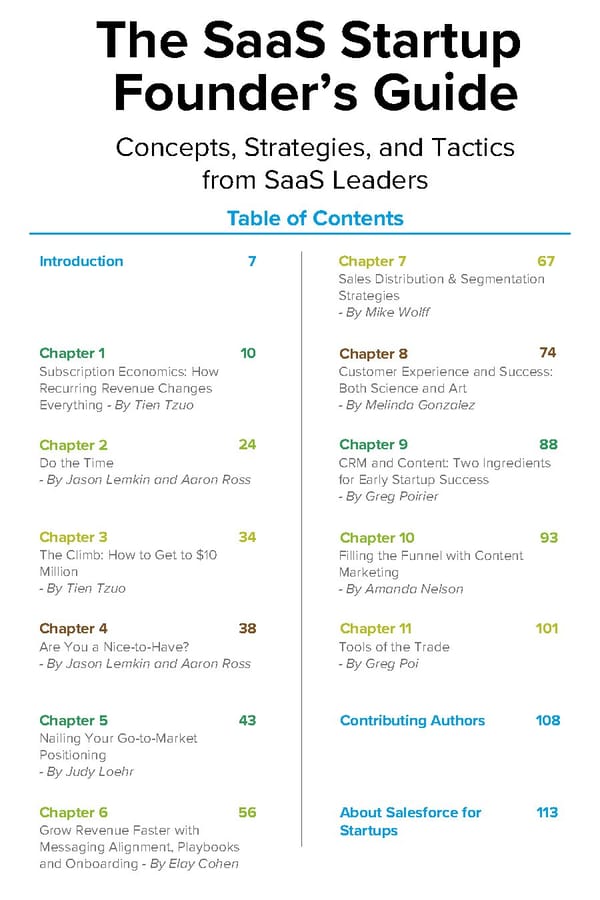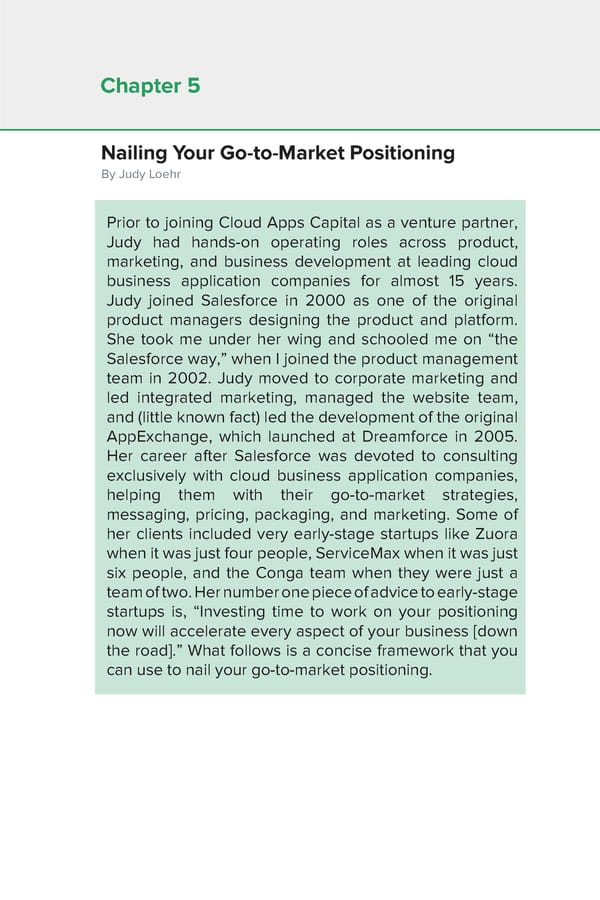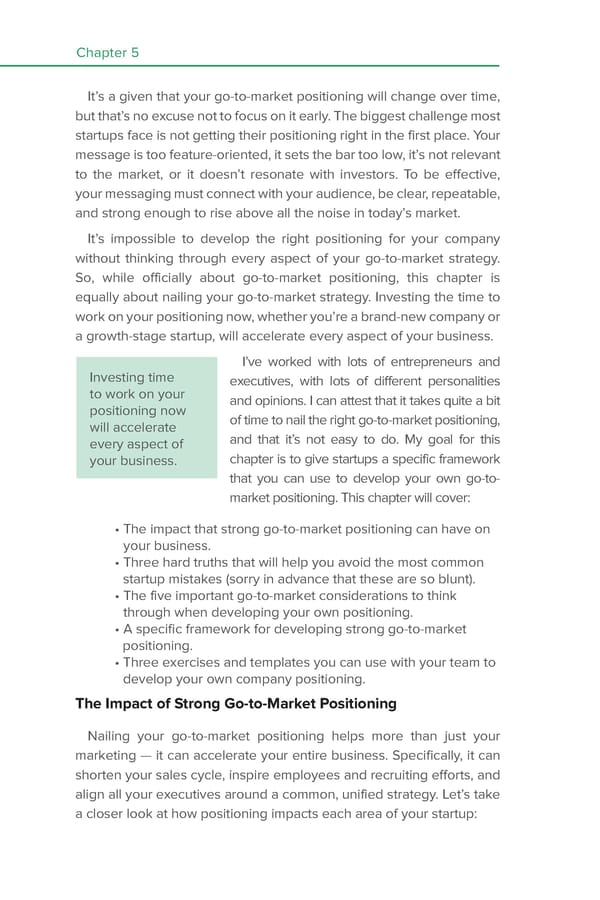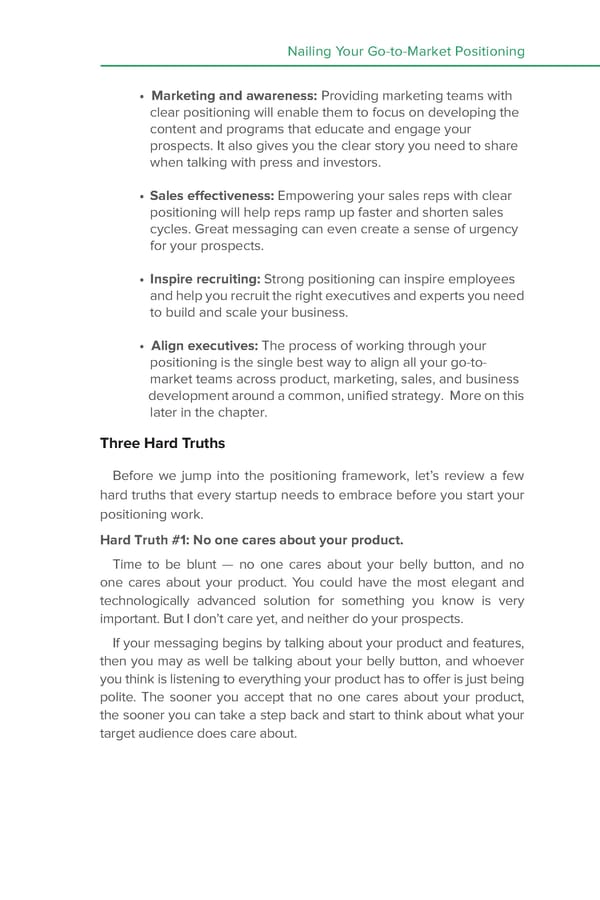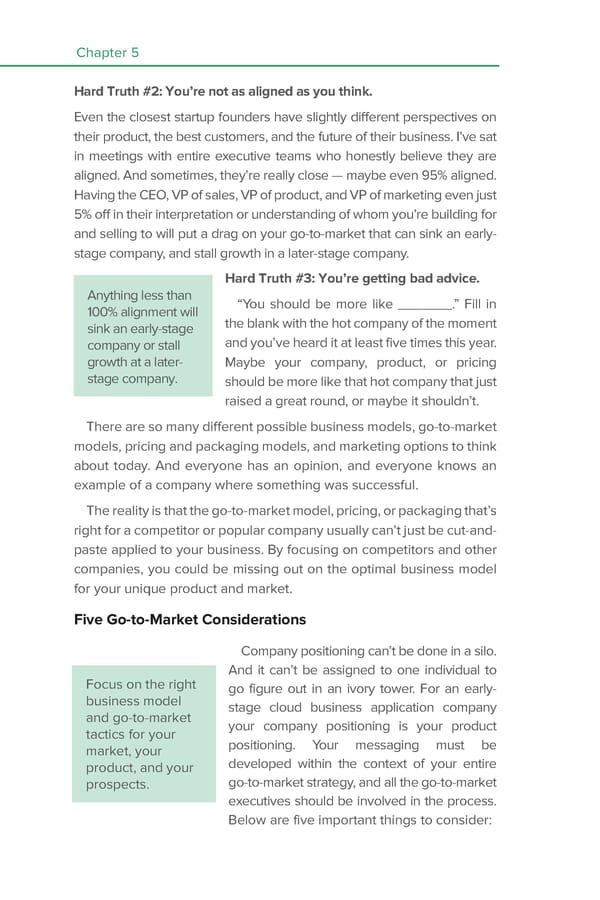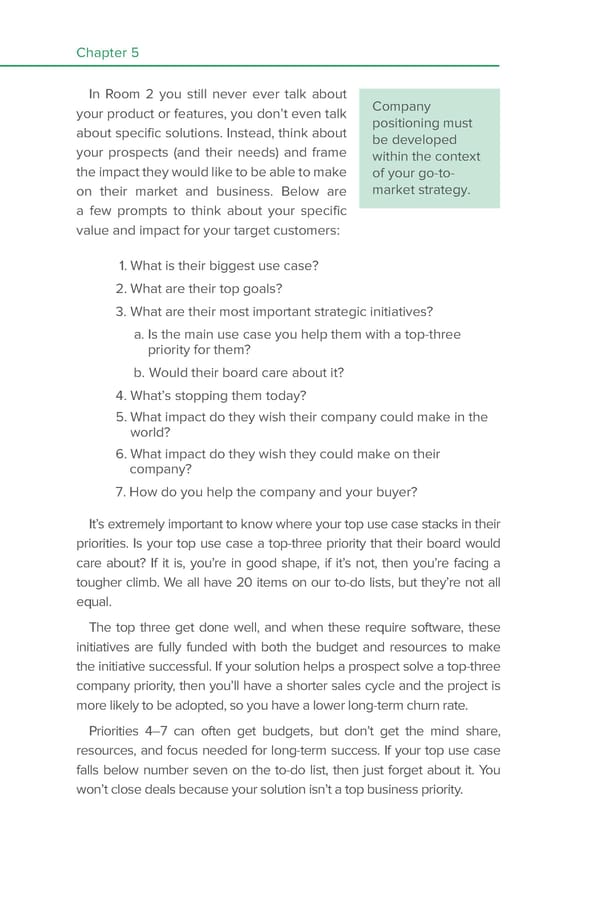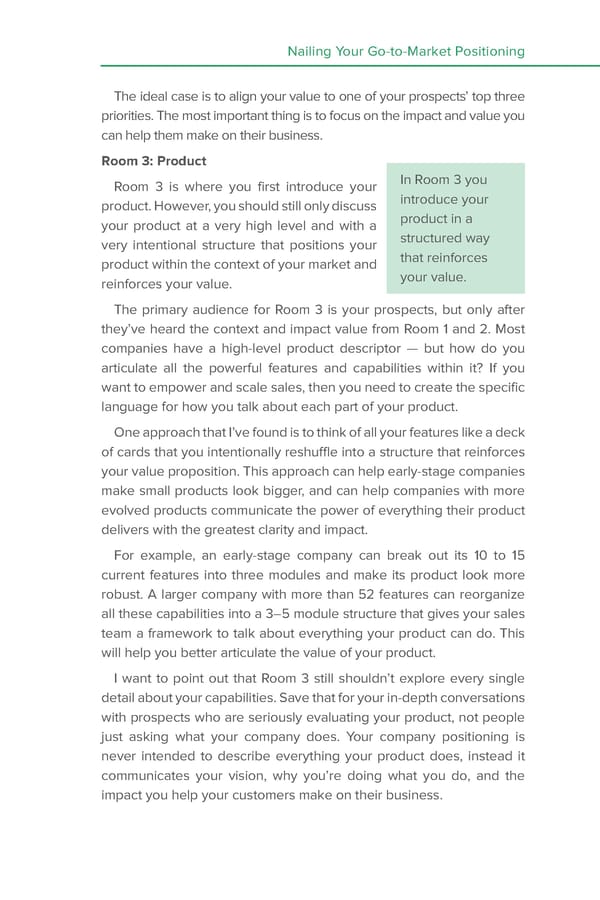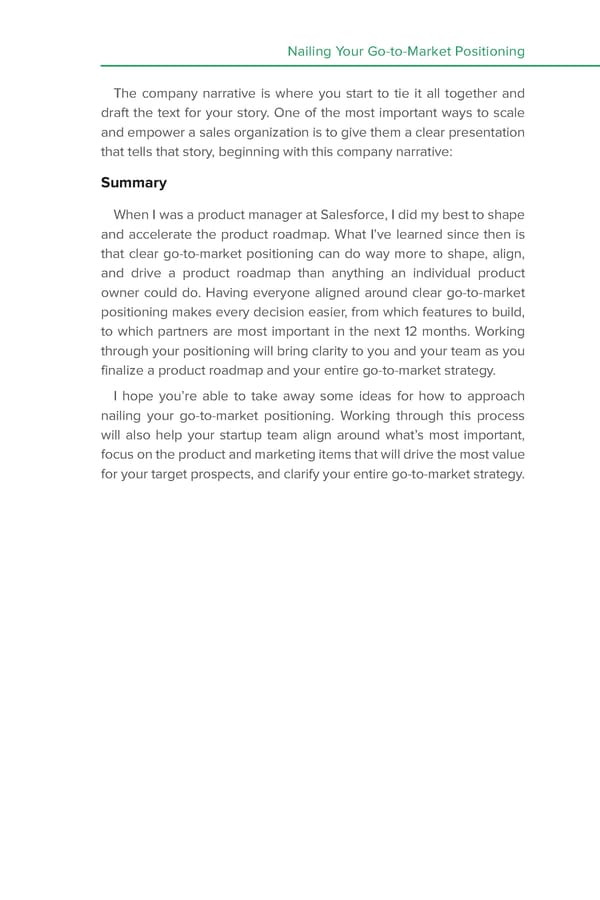Nailing Your Go-to-Market Positioning
By Judy Loehr, Founder, Bayla Ventures
The SaaS Startup Founder’s Guide Concepts, Strategies, and Tactics from SaaS Leaders Table of Contents Introduction 7 Chapter 7 67 Sales Distribution & Segmentation Strategies - By Mike Wolff Chapter 1 10 Chapter 8 74 Subscription Economics: How Customer Experience and Success: Recurring Revenue Changes Both Science and Art Everything - By Tien Tzuo - By Melinda Gonzalez Chapter 2 24 Chapter 9 88 Do the Time CRM and Content: Two Ingredients - By Jason Lemkin and Aaron Ross for Early Startup Success - By Greg Poirier Chapter 3 34 Chapter 10 93 The Climb: How to Get to $10 Filling the Funnel with Content Million Marketing - By Tien Tzuo - By Amanda Nelson Chapter 4 38 Chapter 11 101 Are You a Nice-to-Have? Tools of the Trade - By Jason Lemkin and Aaron Ross - By Greg Poi Chapter 5 43 Contributing Authors 108 Nailing Your Go-to-Market Positioning - By Judy Loehr Chapter 6 56 About Salesforce for 113 Grow Revenue Faster with Startups Messaging Alignment, Playbooks and Onboarding - By Elay Cohen
Chapter 4 Are You a Nice-to-Have? Chapter 5 Nailing Your Go-to-Market Positioning By Judy Loehr Prior to joining Cloud Apps Capital as a venture partner, Judy had hands-on operating roles across product, marketing, and business development at leading cloud business application companies for almost 15 years. Judy joined Salesforce in 2000 as one of the original product managers designing the product and platform. She took me under her wing and schooled me on “the Salesforce way,” when I joined the product management team in 2002. Judy moved to corporate marketing and led integrated marketing, managed the website team, and (little known fact) led the development of the original AppExchange, which launched at Dreamforce in 2005. Her career after Salesforce was devoted to consulting exclusively with cloud business application companies, helping them with their go-to-market strategies, messaging, pricing, packaging, and marketing. Some of her clients included very early-stage startups like Zuora when it was just four people, ServiceMax when it was just six people, and the Conga team when they were just a team of two. Her number one piece of advice to early-stage startups is, “Investing time to work on your positioning now will accelerate every aspect of your business [down the road].” What follows is a concise framework that you can use to nail your go-to-market positioning.
Chapter 5 Nailing Your Go-to-Market Positioning It’s a given that your go-to-market positioning will change over time, but that’s no excuse not to focus on it early. The biggest challenge most startups face is not getting their positioning right in the first place. Your message is too feature-oriented, it sets the bar too low, it’s not relevant to the market, or it doesn’t resonate with investors. To be effective, your messaging must connect with your audience, be clear, repeatable, and strong enough to rise above all the noise in today’s market. It’s impossible to develop the right positioning for your company without thinking through every aspect of your go-to-market strategy. So, while officially about go-to-market positioning, this chapter is equally about nailing your go-to-market strategy. Investing the time to work on your positioning now, whether you’re a brand-new company or a growth-stage startup, will accelerate every aspect of your business. I’ve worked with lots of entrepreneurs and Investing time executives, with lots of different personalities to work on your and opinions. I can attest that it takes quite a bit positioning now of time to nail the right go-to-market positioning, will accelerate and that it’s not easy to do. My goal for this every aspect of your business. chapter is to give startups a specific framework that you can use to develop your own go-to- market positioning. This chapter will cover: • The impact that strong go-to-market positioning can have on your business. • Three hard truths that will help you avoid the most common startup mistakes (sorry in advance that these are so blunt). • The five important go-to-market considerations to think through when developing your own positioning. • A specific framework for developing strong go-to-market positioning. • Three exercises and templates you can use with your team to develop your own company positioning. The Impact of Strong Go-to-Market Positioning Nailing your go-to-market positioning helps more than just your marketing — it can accelerate your entire business. Specifically, it can shorten your sales cycle, inspire employees and recruiting efforts, and align all your executives around a common, unified strategy. Let’s take a closer look at how positioning impacts each area of your startup:
Chapter 5 Nailing Your Go-to-Market Positioning • Marketing and awareness: Providing marketing teams with clear positioning will enable them to focus on developing the content and programs that educate and engage your prospects. It also gives you the clear story you need to share when talking with press and investors. • Sales effectiveness: Empowering your sales reps with clear positioning will help reps ramp up faster and shorten sales cycles. Great messaging can even create a sense of urgency for your prospects. • Inspire recruiting: Strong positioning can inspire employees and help you recruit the right executives and experts you need to build and scale your business. • Align executives: The process of working through your positioning is the single best way to align all your go-to- market teams across product, marketing, sales, and business development around a common, unified strategy. More on this later in the chapter. Three Hard Truths Before we jump into the positioning framework, let’s review a few hard truths that every startup needs to embrace before you start your positioning work. Hard Truth #1: No one cares about your product. Time to be blunt — no one cares about your belly button, and no one cares about your product. You could have the most elegant and technologically advanced solution for something you know is very important. But I don’t care yet, and neither do your prospects. If your messaging begins by talking about your product and features, then you may as well be talking about your belly button, and whoever you think is listening to everything your product has to offer is just being polite. The sooner you accept that no one cares about your product, the sooner you can take a step back and start to think about what your target audience does care about.
Chapter 5 Nailing Your Go-to-Market Positioning Hard Truth #2: You’re not as aligned as you think. Even the closest startup founders have slightly different perspectives on their product, the best customers, and the future of their business. I’ve sat in meetings with entire executive teams who honestly believe they are aligned. And sometimes, they’re really close — maybe even 95% aligned. Having the CEO, VP of sales, VP of product, and VP of marketing even just 5% off in their interpretation or understanding of whom you’re building for and selling to will put a drag on your go-to-market that can sink an early- stage company, and stall growth in a later-stage company. Hard Truth #3: You’re getting bad advice. Anything less than “You should be more like _______.” Fill in 100% alignment will the blank with the hot company of the moment sink an early-stage company or stall and you’ve heard it at least five times this year. growth at a later- Maybe your company, product, or pricing stage company. should be more like that hot company that just raised a great round, or maybe it shouldn’t. There are so many different possible business models, go-to-market models, pricing and packaging models, and marketing options to think about today. And everyone has an opinion, and everyone knows an example of a company where something was successful. The reality is that the go-to-market model, pricing, or packaging that’s right for a competitor or popular company usually can’t just be cut-and- paste applied to your business. By focusing on competitors and other companies, you could be missing out on the optimal business model for your unique product and market. Five Go-to-Market Considerations Company positioning can’t be done in a silo. And it can’t be assigned to one individual to Focus on the right go figure out in an ivory tower. For an early- business model stage cloud business application company and go-to-market your company positioning is your product tactics for your positioning. Your messaging must be market, your product, and your developed within the context of your entire prospects. go-to-market strategy, and all the go-to-market executives should be involved in the process. Below are five important things to consider:
Chapter 5 Nailing Your Go-to-Market Positioning • Your audience segments: Whom are you designing your product for and what is most important to them? One size rarely fits all, especially in business software, so it’s important to clarify your unique target customer segments. You also can’t serve every segment right away. Prioritizing your target segments will help you focus your product, marketing, and sales efforts where you can make the biggest impact. A worksheet is available at the end of this chapter to help you work through this target audience process. • Your channels: Where are your prospects looking and learning? Who influences your target buyer, what other solutions do they rely on, and where do they go to discover new solutions? Most importantly, how do they expect to buy business software? Do they want to trial and set up the product without having to talk with anyone? Or, do they expect to be able to speak to a sales rep who will help them during the evaluation process? • Product messaging: What is the best way to talk about the value your product provides? What are your unique strengths and the top reasons your target buyers would take some time to look at your product? What is the bottom line impact your solution helps them make for their company? A worksheet at the end of this chapter will help you work through your product module messaging. • Pricing and packaging: One size rarely fits all for pricing so it’s important to offer “right-size” packaging for your target customer segments. Pricing and packaging should also emphasize your strengths and can sometimes even be structured in a way that makes your competitors irrelevant. • Customer acquisition costs (CAC) model: Your CAC model is an important reality check for your go-to-market positioning. You could develop great positioning, but if it tees up a go-to- market strategy and business model that isn’t viable, you won’t be able to grow and scale the business. Company positioning is a critical piece of your overall go-to-market strategy and you must make sure your CAC model is sustainable.
Chapter 5 Nailing Your Go-to-Market Positioning As you can see, this isn’t the work of a single afternoon or even a single week. Make sure you carve out plenty of time to do the work well. Also, keep in mind, it’s often helpful to leverage an outside expert who can ask the right questions and help guide your team through this process so that you can quickly arrive at the strongest possible positioning for your market. Company positioning must be developed within the context of your go-to-market strategy. MESSAGING PRICING & CAC AUDIENCE CHANNELS PACKAGING MODEL Your unique Where are they Must be developed “Right-size” for Work through segments looking and within the context of your segments your acquisition learning? everything else and your model and costs strengths Developing Your Positioning Three Rooms: A Guided Messaging Structure So, what’s the secret to great messaging? You need to be able to talk at three different levels — your product, your value proposition, and your story. One way to approach this is by thinking of your positioning within three distinct rooms. With the three rooms strategy, you visualize your messaging as a gallery, and you’re walking your audience through three distinct rooms. Room 1: Context Room 2: Value Room 3: Product Often called the why, The focus here is on it’s really the why now. your target customer Consider what’s going segments — how the on in your market and why now context is what makes you impacting them, and relevant to your target the impact you could audience. help them make on their business. You can think of this as a curated path through a museum, or if you’ve been to an Ikea recently, as the intentional path the Ikea designers have us walk through each room of the store. Let’s dive into each of these three rooms in more detail:
Chapter 5 Nailing Your Go-to-Market Positioning Room 1: Context Your company exists within the context of your market. Room 1 is where you create a compelling context for your company that’s framed within the market and what’s happening in your customers’ businesses. The primary audiences for your Room 1 messaging are media and investors, but it also gives you very important context and purpose for your prospects and employees. Below are some questions to help you think about your market context: 1. What’s happening in your market today? 2. What’s new in your target buyer’s world? 3. Is there anything putting pressure on them? 4. Are you attacking an established model that’s even bigger than your market? 5. How are you relevant to what’s happening in your market? 6. Why is this happening and why is it important now? Many marketers often call this the why part Never mention of your story, it’s actually the why now that your company or creates a sense of purpose and urgency for your product in your company and customers. Room 1. Notice what’s not in Room 1. There’s no mention of your product and features in Room 1. There’s not even any mention of your company in Room 1. The most important rule to remember about Room 1 is that you never mention your company or your product. Your company doesn’t exist in Room 1. Room 1 is all about your customers’ market and what’s happening in their world, not about you (or your belly button). Room 2: Value The primary audience for Room 2 is your prospects. Room 2 is where you clearly articulate your value for your target customers, tie in how the why now is impacting them, and introduce the impact you could help them make on their business.
Chapter 5 Nailing Your Go-to-Market Positioning In Room 2 you still never ever talk about your product or features, you don’t even talk Company about specific solutions. Instead, think about positioning must be developed your prospects (and their needs) and frame within the context the impact they would like to be able to make of your go-to- on their market and business. Below are market strategy. a few prompts to think about your specific value and impact for your target customers: 1. What is their biggest use case? 2. What are their top goals? 3. What are their most important strategic initiatives? a. Is the main use case you help them with a top-three priority for them? b. Would their board care about it? 4. What’s stopping them today? 5. What impact do they wish their company could make in the world? 6. What impact do they wish they could make on their company? 7. How do you help the company and your buyer? It’s extremely important to know where your top use case stacks in their priorities. Is your top use case a top-three priority that their board would care about? If it is, you’re in good shape, if it’s not, then you’re facing a tougher climb. We all have 20 items on our to-do lists, but they’re not all equal. The top three get done well, and when these require software, these initiatives are fully funded with both the budget and resources to make the initiative successful. If your solution helps a prospect solve a top-three company priority, then you’ll have a shorter sales cycle and the project is more likely to be adopted, so you have a lower long-term churn rate. Priorities 4–7 can often get budgets, but don’t get the mind share, resources, and focus needed for long-term success. If your top use case falls below number seven on the to-do list, then just forget about it. You won’t close deals because your solution isn’t a top business priority.
Chapter 5 Nailing Your Go-to-Market Positioning The ideal case is to align your value to one of your prospects’ top three priorities. The most important thing is to focus on the impact and value you can help them make on their business. Room 3: Product Room 3 is where you first introduce your In Room 3 you product. However, you should still only discuss introduce your your product at a very high level and with a product in a very intentional structure that positions your structured way product within the context of your market and that reinforces reinforces your value. your value. The primary audience for Room 3 is your prospects, but only after they’ve heard the context and impact value from Room 1 and 2. Most companies have a high-level product descriptor — but how do you articulate all the powerful features and capabilities within it? If you want to empower and scale sales, then you need to create the specific language for how you talk about each part of your product. One approach that I’ve found is to think of all your features like a deck of cards that you intentionally reshuffle into a structure that reinforces your value proposition. This approach can help early-stage companies make small products look bigger, and can help companies with more evolved products communicate the power of everything their product delivers with the greatest clarity and impact. For example, an early-stage company can break out its 10 to 15 current features into three modules and make its product look more robust. A larger company with more than 52 features can reorganize all these capabilities into a 3–5 module structure that gives your sales team a framework to talk about everything your product can do. This will help you better articulate the value of your product. I want to point out that Room 3 still shouldn’t explore every single detail about your capabilities. Save that for your in-depth conversations with prospects who are seriously evaluating your product, not people just asking what your company does. Your company positioning is never intended to describe everything your product does, instead it communicates your vision, why you’re doing what you do, and the impact you help your customers make on their business.
Chapter 5 Nailing Your Go-to-Market Positioning Positioning Exercises and Templates In this section, I’ve provided three road-tested templates that you can use with your teams to work on your own go-to-market positioning. Exercise 1: Target Audience Matrix The first, and most important, step in your effort to develop clear and compelling company positioning is to have clarity on your audience. You can’t start messaging without first defining and achieving internal alignment on the prospects you are building your product for, marketing, and selling to. Since there’s no one-size-fits-all in business software, it’s important to think about your target audience in terms of clear segments and profiles. This template will help you work through what’s most important for each of your target segments. It requires you think through: 1. Main use case your company could help with. 2. Top challenge (related to their goal or use case). 3. Reason why a prospect would choose your solution. Startups typically have between 3–5 unique target customer segments. Startups don’t have the resources to build product, market, and sell to every segment at once. 3 - 5 cl wha ea r t th ey se gment nee s d to do SEGMENT SPECIFIC USE CASE Customer segment 1 Very short and to the point Very short description statement of what they need to do • Sample company • Sample company ... so they can (5 words) “Colorful, between-friends expression here.” ey ts th fi ene he b t t’s hindering wha t from ge ll wi se heiR use ca t on ti lu ur so yo CURRENT CHALLENGE ($) REASONS TO CHOOSE (YOU) Biggest blocker here Short headline (1 line only) (what’s stopping them) • Biggest impact 1 ... with capability A Ex: “But i can’t because it still takes 15 hours to pull all the data together each week.” • Biggest impact 2 ... enable by feature B • Biggest impact 3 ... with rich capability C
Chapter 5 Nailing Your Go-to-Market Positioning So, it’s just as important to clearly identify segments that you’re not going to go after as it is to identify your best-fit segments. Here are a few tips for working on your own target audience matrix: 1. The use case needs to be the most important use case for that specific segment. It shouldn’t be what you wish their top priority or use case was, but what it really is. It’s critical to make sure these are honest summaries about your target customers and what their top priorities and corresponding challenges really are. 2.The colorful expressions in quotes are a great way to bring each segment to life. Most of this matrix will be in professional speak, but the quotes illustrate how it’s stated between friendly colleagues. The information in this matrix will inform your company positioning and can also be the foundation for your future website copy. Exercise 2: Product Messaging The product module matrix is where you reshuffle all of your product capabilities into a structure that conveys the breadth and depth of your product. I recommend 3–5 modules total. Make sure you tediously flesh out the exact messaging for each module. If you don’t, then your sales reps and prospects will be forced to try to describe the value of each module themselves, and no one will be happy with those results. The information in this matrix will inform your company positioning o tr ome in ll bec wi ine and adl e h ome bec ur can yo on py 5 co - 3 ge pa t uc rod t p uc s on a llet od bu pr e’s it bs les we odu m te si eb w ur yo ge on pa il ta de MODULE LEADERSHIP MESSAGE REASONS TO CHOOSE (YOU) MODULE 1 Biggest impact value here (short) Short headline for this module (1 line only) Very short description • Included feature 1 ... with your proof point/enabler here • Included feature 2 • Included feature 3
Chapter 5 Nailing Your Go-to-Market Positioning and be used as the foundation for the future product section of your website. Imagine one product detail page per line in this matrix and you’ll see that you’re framing the benefits and impact of each feature, in addition to cataloging all the capabilities within each module. Exercise 3: Your Company Narrative 1) Start with what’s happening in the market ... that is affecting your in their terms, for their target customers needs and goals • What’s causing pressure? • This is not yet about you • What’s being disrupted? or your product • What’s disrupting your • Do not mention your customers’ world? company or product yet (CONTEXT) • Just tee up what an ideal solution would look like • Keep it in the context you set up 2) Frame their current 4) Now introduce your situation ... company’s vision ... and how it is hurting or and high-level value challenging them of your product • What are they currently • “That’s why we started having to deal with and do now? [COMPANY]” • What option do they have? • “To help companies struggling • Highlight the pitfalls/risks with ... transforming into ... etc.” of their current options • Avoid product detail; just give one-line overview of your product and then focus on how it helps your target customers (FROM TARGET AUDIENCE (FROM TARGET MODULE MATRIX) MATRIX)
Chapter 5 Nailing Your Go-to-Market Positioning The company narrative is where you start to tie it all together and draft the text for your story. One of the most important ways to scale and empower a sales organization is to give them a clear presentation that tells that story, beginning with this company narrative: Summary When I was a product manager at Salesforce, I did my best to shape and accelerate the product roadmap. What I’ve learned since then is that clear go-to-market positioning can do way more to shape, align, and drive a product roadmap than anything an individual product owner could do. Having everyone aligned around clear go-to-market positioning makes every decision easier, from which features to build, to which partners are most important in the next 12 months. Working through your positioning will bring clarity to you and your team as you finalize a product roadmap and your entire go-to-market strategy. I hope you’re able to take away some ideas for how to approach nailing your go-to-market positioning. Working through this process will also help your startup team align around what’s most important, focus on the product and marketing items that will drive the most value for your target prospects, and clarify your entire go-to-market strategy.

